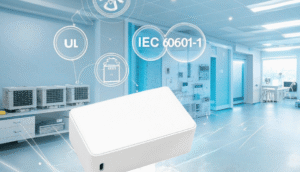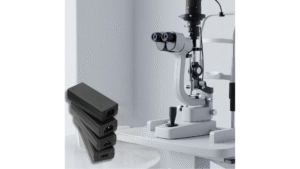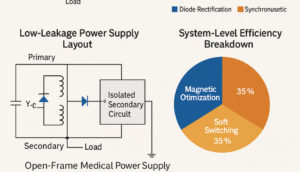Medical power supplies are designed with several critical safety features to ensure the safety of patients and the reliability of medical equipment. Here are key aspects that ensure this safety:
1. Isolation and Leakage Current
- Isolation: Medical power supplies often use isolation transformers to separate the high-voltage input from the low-voltage output, reducing the risk of electric shock.
- Leakage Current: Strict limits on leakage current (the unintended current that flows from the power supply to ground) help to prevent electrical shocks. Medical standards specify very low leakage currents for different types of medical devices.
2. Compliance with Standards
- Regulatory Standards: Medical power supplies must comply with international standards such as IEC 60601-1, which sets stringent requirements for safety, performance, and electromagnetic compatibility.
- Certification: Products are tested and certified by recognized bodies (e.g., UL, CSA, TUV) to ensure compliance with these standards.
3. Redundancy and Reliability
- Redundancy: Critical medical equipment often uses redundant power supplies to ensure continuous operation in case one power supply fails.
- Reliability: High-reliability components and robust design practices are employed to ensure long-term operation without failure.
4. Electromagnetic Compatibility (EMC)
- EMC Requirements: Medical power supplies must minimize electromagnetic interference (EMI) and be immune to EMI from other devices. This ensures that the power supply does not interfere with other sensitive medical equipment and vice versa.
5. Overload and Overvoltage Protection
- Overload Protection: Power supplies are designed with overload protection to prevent damage to both the power supply and the connected equipment in the event of excessive current draw.
- Overvoltage Protection: This feature protects equipment from voltage spikes or surges that could cause malfunction or damage.
6. Temperature Management
- Thermal Management: Adequate cooling and thermal management are critical to prevent overheating, which can lead to failure or unsafe operation.
- Temperature Monitoring: Some power supplies include temperature sensors and shut-down mechanisms to protect against overheating.
7. Safety Interlocks and Alarms
- Safety Interlocks: These prevent the operation of equipment under unsafe conditions.
- Alarms: Audible or visual alarms alert medical personnel to power supply issues that need immediate attention.
8. Physical Design
- Insulation: High-quality insulation materials are used to prevent electrical faults.
- Enclosures: Power supplies are often housed in protective enclosures that prevent accidental contact with high-voltage components and are designed to be easy to clean and maintain.
9. Battery Backup
- Uninterruptible Power Supplies (UPS): Some medical devices are equipped with UPS to ensure continuous operation during power outages or fluctuations.
- Battery Management Systems: These ensure the health and readiness of backup batteries, providing reliable power when needed.
10. Regular Testing and Maintenance
- Periodic Testing: Regular testing and maintenance schedules are crucial to ensure ongoing compliance with safety standards and reliable operation.
By incorporating these features, medical power supplies help to safeguard patients and medical personnel from electrical hazards while ensuring the reliable performance of critical medical equipment.









